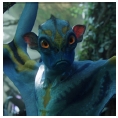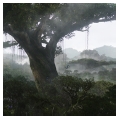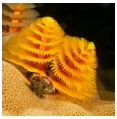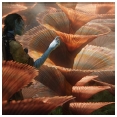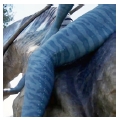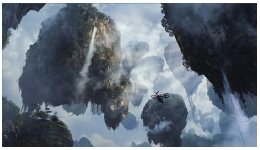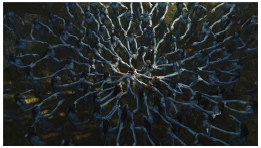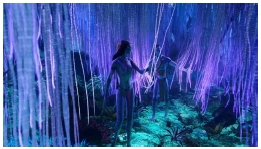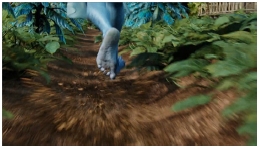
Analysis of Viewers’ Appreciation for the Imaginary Pandora in the Movie Avatar
Abstract
Background The movie Avatar has been the most successful film in sales for ten years since its release in 2009. Although some researchers have found the worth of this film based on aesthetic interpretation, these works still fail to explain the film’s massive popularity. Our goal is to suggest explicit design directions by predicting the audience's appreciation not from an aesthetic interpretation but through psychological analysis.
Methods Based on multiple psychological theories, this study attempts to verify two hypotheses. First, scenes in which the audience experienced good feelings will reveal the Earth's natural landscape. Second, viewers will experience good feelings even if Pandora's landscape exaggerates natural patterns. To this end, 215 subjects were asked to select the most impressive scenes from Avatar and to identify the feelings evoked by each scene.
Results After analyzing the five most impressive scenes, we concluded that our two hypotheses were reflected in these scenes. First, the audience chose “like” when the scenes presented natural scenery. Second, the viewers experienced positive feelings by watching exaggerated natural features, especially patterns in nature. In the later scenes, the viewers chose “like” more than those showing realistic natural features.
Conclusions The scenery of Pandora reflects actual features or amplified patterns observed in nature from a psychological perspective. We have empirically confirmed the structure of a design that elicits positive feelings from a general, rather than critical, perspective. Consequently, the method presented in this study can serve as a practical guide to help reproduce the film’s visual appearance.
Keywords:
Avatar, James Cameron, Visual Effects, Peak Shift, Production Design1. Introduction
1. 1. Background
The movie Avatar has consistently been among the most successful films in sales since its release in 2009. According to Box Office Mojo (2021), Avatar grossed 2.8 billion dollars the year it was released, more than Hyundai Motor's total sales during all of 2009. However, even though the collected empirical evidence testifies to the public's fascination with the film, aesthetic theorists have been unable to explain why it attracted such an enormous audience. Avatar's narrative and themes, focusing on the plight of an indigenous species when foreigners arrive and the way an outsider can become part of a group, have been shown on the silver screen repeatedly. Although some studies have emphasized the film’s technical excellence and its use of 3D effects, these analyses fail to explain its massive popularity. Indeed, previous analyses leave scholars wondering what an Avatar viewer experiences in general.
Arguing that James Cameron considers multiple psychological theories when creating his productions, this study examined those theories and their applications to the movie Avatar. The movie depicts the imaginary planet Pandora's novel ecology, which, according to crew interviews and literature, was designed to be easily recognizable and relatable to the audience. Based on psychological research, we predicted that audiences would positively experience the planet Pandora due to its similarities with nature's actual appearance and patterns. To confirm our prediction, we recruited 215 people to watch Avatar in a closed environment. After the screening, we surveyed the participants to determine what scenes were most impressive to them and gauge their emotional responses to those scenes. Our goal was to suggest explicit design directions by using psychological analysis rather than aesthetic interpretation to predict audience appreciation.
2. Background
2. 1. Film analysis of Avatar
While Avatar has proven its popularity in economic terms, it has not received interest from researchers, who traditionally regard the success of Hollywood franchise movies as resulting from massive capital input. As such, some researchers have examined the sociological phenomena aroused by Avatar rather than focusing on the film itself (Adamson, 2012; Holtmeier, 2010). Others have highlighted technical rather than general experiences (Ross, 2012).
Both Mulrooney (2011) and Elsaesser (2011) approached the film itself from an aesthetic perspective. Mulrooney (2011, p. 201) stated, "Despite a deep and obvious engagement with the aims and techniques of popular filmmaking, Cameron's version of contemporary Hollywood cinema inherits a Romantic fascination with ways in which aesthetic experience produces emotion." In this thesis, he identified similarities between Avatar and the work of Keats, a poet representing late Romanticism. Keats' poems focus on capturing and envisioning the stimuli encountered by the body that cannot be translated into thoughts. They offer poetic depictions of the world, but these depictions are always only partial. Likewise, Cameron's 3-D film makes viewers engage with an imaginary world using sensory input; however, actually reaching Pandora is impossible. As such, both Keats's and Cameron's works elicit self-consciousness about the impossibility of actual immersion into an alternative world.
Similarly, Elsaesser (2011) discussed the film aesthetically, analyzing the way Cameron reached aesthetic attainment through Avatar. First, compressing the film into a single storyline gives even audience members with conflicting viewpoints multiple access points to identify themselves in the film. Second, Elsaesser argued (2011, p. 252) that Cameron adds “cognitive dissonance” to the compressed narrative, thereby creating “double binds”— dilemmas in communication in which people receive two or more conflicting messages with one negating the other. This literary device requires audience members to unravel the double binds to reveal the message that affectively engages them. Finally, Cameron uses this self-contradiction, which appears in several layers of the narrative, to fulfill his ambition of affecting a paradigm shift regarding technology.
Clearly, both Mulrooney (2011) and Elsaesser (2011) judged Avatar's value by comparing it with other literary works and analyzing its literary devices. Only people with aesthetic attitudes could enjoy such in-depth interpretations of the film. However, as pointed out earlier, Avatar is a Hollywood film for the masses, making it broadly accessible. As such, we attempted to trace the film’s expressional characteristics to explain the general appreciation it has garnered.
2. 2. The design strategy of Pandora
Elsaesser (2011) asserted that Cameron's personal narrative derives from the deep sea. Indeed, Cameron has not hidden his interest in the ocean, as his film Titanic (1997) and documentary Deepsea Challenge (2014) demonstrate. Elsaesser (2011) pointed out that the Na' vi and the creatures living in the forest mimic the movements of the water, metaphorically highlighting Cameron's interests. Biologists have also pointed out that the director expressed his pro-environmental bias, which is not an environmental awareness, but rather a dramatic expression, through Pandora's ecology (Yoon, 2010).
Biologist Jodie Holt, an advisor on the film’s flora production, said that many of the plants used in the film already exist on Earth, but people were not aware of them. As such, she suggested that the design exaggerated existing natural characteristics (Jabr, 2010). She also talked about Cameron's direction, highlighting that he aimed to make the world of Pandora look both novel and sufficiently familiar for audiences to grasp it in one glance. This intention became apparent in the book Avatar: A Confidential Report on the Biological and Social History of Pandora (James Cameron's Avatar), which was made as part of the film’s promotion to elaborate on Pandora’s similarities and dissimilarities with Earth, based on the premise of Pandora as parallel to Earth (Wilhelm & Mathison, 2009). For example, the landscapes of the Hallelujah Mountains and the Hometree are almost identical to scenes on Earth. According to this explanation, tidal energy is generated on Pandora, causing continental movement, plate collisions, and volcanic activity. As a result, the planet’s geology and climate are similar to those of the Earth (Wilhelm & Mathison, 2009).
The book also states that the animals on Pandora and Earth resemble each other in their food chains rather than their appearances. For instance, the Thanator holds the status of a top predator; the Dierhorse has a similar role to horses; and the Hammerhead parallels elephants (Wilhelm & Mathison, 2009). However, the plants are similar in appearance to many on Earth. The similarities continue with the sea creatures: for example, the Panopyra resembles a jellyfish (Wilhelm & Mathison, 2009). The Helicoradian is not mentioned in the book but looks almost identical to the deep-sea animal Spirobranchus giganteus. In short, seeking to avoid confusing viewers, Cameron chose to exaggerate existing organisms (Wilhelm & Mathison, 2009).
2. 3. Natural patterns observed on Pandora
The literature states that Pandora's ecology evolved according to the laws of natural selection. As a result, environmental factors on Pandora appear to determine its fauna and flora appearance. For example, the Glow Worm evolved to use luminescence to attract pollinators. This trait arose because Pandora's climate resembles Earth's polar regions, providing insufficient exposure to light. In other words, environmental factors such as Pandora's low gravity and low-density atmosphere affect the forms of the creatures that inhibit it. According to Wilhelm and Mathison (2009), the characteristic traits that occurred in Pandora's genetic order are as follows: first, “Bioluminescence,” which allows organisms to emit light; second, “Megafauna,” which means animal life bigger than on Earth; third, responsiveness to touch; and finally, “Zooplantae,” which refers to plants with animal-like nervous systems.
However, except for such environment-generated traits, the forms and structures of most of the organisms on Pandora are the same as those on Earth. Although specific structural features relate to shapes that enhance evolutionary fitness, other forms have developed according to relatively simple physical laws and mechanisms. In this regard, Philip Ball (2016) presented particular growth patterns that create shapes. From this perspective, we identified the following natural patterns observed on Pandora.
First, all Pandora animals have symmetrical shapes. Symmetry is the basic structural feature of animal body shapes because it is suitable for developing spines and central nervous systems. Second, rather than fur, Pandora’s animals have specific patterns on their skin. Ball (2016) described this as a Turing pattern, in which stripes or dots are generated by chemical reactions of activators and inhibitors during development processes. Third, Pandora's woods are identical to many on Earth except for their size, following a fractal structure with self-similarity that repeats hierarchically in a specific pattern—a diffusion-optimized structure that minimizes the energy required to transport fluid. Fourth, the logarithmic spiral, which often appears in Pandora's plants, is also a familiar pattern on Earth. When leaves or seeds are arranged along the Fibonacci sequence, the logarithmic spiral appears to be the most efficient arrangement in limited spaces. Exemplifying this phyllotaxis, the Helicoradian spread and shrink along a helix. Additionally, the chaotic patterns of clouds and waterfalls appear almost the same as on Earth. Thus, these features work in combination to make various natural shapes, and Pandora's ecology follows several patterns observed on Earth (see Table 1).
3. Aesthetic experiences on Pandora
3. 1. Preference for Pandora scenery
As mentioned above, Pandora's natural attributes resemble those of Earth. According to Holt's interview, Pandora was deliberately designed this way because the film’s creators believed audiences would struggle to relate to scenes that appeared too bizarre (Schirber, 2010). In this study, we attempted to determine whether or not a design strategy based on relations to nature makes scenes more attractive to an audience. We started from the assumption that viewing attractive natural features evokes positive reactions in audiences. This hypothesis is based on numerous psychological theories such as attention restoration theory, the prospect-refuge principle, and information theory.
People generally prefer natural landscapes over artificial places (Kaplan et al., 1972). Kaplan's "attention restoration theory (ART)" provides a good case in point; drawing on previous research regarding involuntary attention and voluntary or goal-directed attention, it asserts that people can concentrate better after looking at nature scenes (Kaplan, 1995; Hartig et al., 1991). Goal-directed attention derives from mental fatigue, while mental fatigue has little effect on stimulus-driven attention. Nature enables people to obtain stimulus-driven attention by presenting fascinating objects. Kaplan (1995) referred to phenomena such as clouds or leaves rustling in a breeze, which attract our attention relatively effortlessly and are compatible with our wants and needs, as “soft fascinations.” Attention restoration theory insists that looking at natural landscapes allows brain activity to remain in the default mode network and relax the relentless focus required in everyday life (Boksem et al., 2005).
In addition, some evolutionary psychologists have attempted to demonstrate preferences for specific landscapes based on habitat selection conditions. Appleton (1996) developed the prospect-refuge theory to explain preferences for specific landscapes. This theory argues that people experience enjoyment and safety in habitats that provide both open views and feelings of enclosure (Appleton, 1996). Places with broad views satisfy the desire for opportunities to acquire information useful for survival. On the other hand, environmental enclosures fulfill the desire for safety.
Furthermore, in proposing arousal theory, Berlyne (1951) suggested that pleasure is evoked when a person views a space or scene with a degree of uncertainty or novelty. Kaplan (1987) also developed information theory, which states that complex, mysterious environments provide increased opportunities for gathering or discovering information. As such, humans are likely to prefer moderately complex and mysterious spaces such as paths with hidden corners (Kaplan, 1987). While such paths have potential risks, they also represent opportunities to acquire resources and are identified as suitable habitats for information collection. Thus, exploration potential also has an impact on environmental preference.
Such natural scenery is frequently featured in Avatar. For example, the image on the left in Figure 1 shows where Sully and the Na'vi interact and handle their Ikran. The place can be seen as exemplifying Appleton's (1996) prospect-refuge theory. Both the Na'vi and the audience may experience pleasure and safety in this cave-like space that provides both an uncovered view and feelings of enclosure. The image on the right in Figure 1 depicts one of the scenes in which the main protagonist learns the customs of the Na’vi tribe by following Neytiri. This scene matches Kaplan’s (1987, p. 8) example, “a trail that disappeared around the bend or a brightly lit clearing partially obscured from view by intervening foliage.” This environment is quite similar to Earth’s forests and paths, arousing the desire to move forward, despite potential dangers like snakes.
In this study, we predicted that audiences would most prefer Pandora scenes with environmental characteristics extracted from ART, the prospect-refuge principle, and information theory.
3. 2. Aesthetic pleasure in Pandoran creatures
While Pandora's creatures resemble Earth's flora and fauna, they are not identical. In particular, the phenomenon of "Post-Avatar Depression," caused by viewers’ unwillingness to admit that Pandora's splendid living entities do not exist on Earth, suggests that audiences are unaware that the traits of Pandora's creatures originated from natural patterns on Earth (Mulrooney, 2011, p. 204). Therefore, we examined whether audiences can experience positive feelings that originate from nature even if they do not notice nature's patterns.
From a neuroscientific perspective, the perceptual brain area processes sensory input to recognize objects via a bottom-up process (Goldstein, 2014). In parallel, cognition aids perceptual processing, providing an attentional set and using it to bias the processing of incoming visual information (Corbetta & Shulman, 2002). This is called top-down processing; it facilitates initial visual processing by reminding viewers of objects implied by visual stimuli (Ramachandran & Hirstein, 1999). That is, the brain does not simply perceive visual objects as they appear; it recognizes objects by comparing them to implicit information.
Ramachandran and Hirstein (1999) identified the peak shift effect, one of the eight laws of artistic experience, as one of the most critical aesthetic experiences. According to the peak shift effect, animals sometimes respond more strongly to exaggerated stimuli. Researchers have described the peak shift effect as a mechanism that encourages animals to approach survival resources by exaggerating and recognizing stimuli that improve survival possibilities, such as sexual dimorphism and waist-hip ratio (Chatterjee, 2014; Pazhoohi et al., 2020). Previously, Reber et al. (2004) had proposed the concept of processing fluency as an explanation for people’s preference for exaggeration. Exaggeration may facilitate processing even more by emphasizing central features and discarding others. The researchers stated that this processing fluency triggers positive feelings:
High fluency may elicit positive affect because it is associated with progress toward successful recognition of the stimulus, error-free processing, or the availability of appropriate knowledge structures to interpret the stimulus. High fluency may also feel good because it signals that an external stimulus is familiar and thus unlikely to be harmful. (Reber et al., 2004, p. 366)
This theory encompasses both perceptual and conceptual fluency. On the one hand, perceptual variables that facilitate fluent processing include figural goodness, symmetry, and figure-ground contrast. On the other hand, conceptual fluency involves the meaning of stimuli and semantic knowledge structures.
Pandora’s creatures exhibit exaggerated characteristics, mainly derived from patterns that exist in nature, as Table 1 shows. For example, the Helicoradian shrinks along its spiral configuration, so its spiral pattern becomes more recognizable. Other plants also accentuate their figures in dark environments by emitting light. Taken together processing fluency theory and the peak-shift effect suggest that Pandoran creatures can elicit nature-derived positive feelings in audiences. Therefore, we predicted that the two methods—showing nature's actual appearance and its amplified patterns—would cause Pandora to inspire positive reactions.
3. 3. Methods of analysis
Based on the psychological theories presented in Table 2, this study tested the following two hypotheses: first, scenes in which the audience experiences good feelings will exhibit characteristics of Earth's natural landscape; and second, viewers will also experience good feelings even if Pandora's landscape exaggerates natural patterns. To this end, we asked the study’s 215 subjects to select the most impressive scenes from Avatar and identify the affects evoked by each scene.
We began developing the questionnaire by asking 50 participants to list the film’s most impressive scenes. Participants submitted text files in which they described the scenes themselves, and they were limited to listing 10 scenes. We used the 20 most-mentioned scenes in this initial survey in the next stage; we took the list of 20 scenes, gave it to 215 participants, and asked them to narrow it down to the ten most impressive scenes. We then asked them to choose a word that best described their emotional reactions to each scene; the options were “like, dislike, anger, or fear.” This provided us with accurate and simple descriptions of their emotional responses. A total of 45 men and 170 women participated in our study. The average age of participants was 22 years old. Nationalities represented included Chinese (103), Korean (101), and Turkish (1). Questions were posed in Korean, and all test subjects were enrolled in a class related to reviewing the movie Avatar.
4. Results
4. 1. Results of the preliminary survey
In our preliminary survey, we attempted to identify the type of scenes that viewers found most impressive. Specifically, we checked whether the scenes chosen for the next test were selected for their visual quality or something else.
Table 3 displays the most impressive twenty scenes chosen for the second test in their temporal sequence within the film. These scenes were also classified based upon the respondents’ descriptions of them. In the earlier scenes representing the characteristic features of Pandora, the participants tended to describe the scenes by referring to visual features such as the unfamiliar Pandora environment and the Na’vi customs. On the other hand, in later scenes, the participants’ descriptions were contextual rather than visual, even if the scenes in question have characteristic features. For example, they often used the word “beautiful” or “mysterious” to explain why they chose earlier scenes, while in later scenes, they used words such as “grieved” or “relieved,” which reflect the narrative. One of these contextual scenes focuses on the protagonist getting kicked out of the group, only to return as a hero. Another scene chosen for storyline reasons features the disguised protagonist revealing his true self to his interspecies lover. These are standard scenes that appear in many movies and can be regarded as cliché; our participants deemed these scenes impressive. Through this survey and analysis, we concluded that the participants chose scenes that were impressive to them for both visual and contextual reasons.
4. 2. Survey analysis
This section presents our structural analysis of the ways nature is expressed in the five scenes selected as the most impressive; we observed the scenes' qualities to confirm whether or not the audience accepted the design strategies. In Table 4 and the text below, we discuss the survey results in relation to our predictions.
The most impressive scene, selected 148 times, shows the seeds from the Tree of Souls sinking into the protagonist's body. About 68.8% of the participants selected this scene, and 204 participants (about 98.9%) chose the word “like” to describe it. This scene includes exaggerated visual features—the seeds emit light and move by themselves. The emitted light accentuates configuration patterns, such as the radial symmetry of the dandelion seeds and their jellyfish-like movement, against the dark background.
The second most impressive scene, according to respondents, depicts the first encounter with the Hallelujah mountains. About 58.1% of all participants chose this scene, and 197 participants (about 91.6%) chose the word “like” to describe their reaction to it. Except for the unusual concept of floating rocks, the entire landscape resembles many landscapes on Earth. The waterfalls and vines seem to follow the gravitational energy. The islands and flowing clouds are identical to such features on Earth. Nothing is exaggerated; rather, this scene reflects nature itself, exemplifying the "soft fascinations," identified by Kaplan (1995).
The third most popular scene depicts the protagonist’s acceptance into the Omaticaya clan and all the characters putting their arms on each other’s shoulders. About 57.7% of all participants chose this scene, and 176 participants (about 81.9%) chose the emotion “like,” relatively lower than the percentage who reacted positively to the other scenes. This scene does not depict features of nature, but does show a geometric pattern slowly formed by several bodies. Viewers cannot recognize the natural features of this pattern, meaning it cannot elicit the positive feelings derived from nature. However, the movement that is gradually created when the characters place their hands on each other’s shoulders might enable viewers to recognize the pattern, as process fluency theory explains.
The fourth-ranked scene shows the two main protagonists sharing their feelings under the Tree of Souls; about 54.9% of all participants chose this scene and 206 participants (about 95.8%) characterized their reaction as “like.” As expected, this scene displays trees similar to willows. The light emitted by the branches allows the audience to recognize their natural shape and movement in the breeze. Additionally, this Pandoran tree is more impactful than normal trees because it emits light when touched. The response to touch enables viewers to easily recognize the tree’s natural shape because the light creates more contrast, allowing viewers to focus on its shape and movement.
Finally, the fifth most identified scene, chosen by about 54% of participants, shows the protagonist starting to run using the avatar's body. For this scene, 197 participants (about 91.6%) chose the word “like.” The avatar compound, a facility intended to help new avatar controllers, provides an Earth-like environment, so all of the visuals are similar to Earth, including the flora's green color, phyllotaxis, and the pattern of splashing soil.
4. 3. Discussion
After analyzing the five most impressive scenes, we concluded that they reflected our two hypotheses. First, we assumed that the audience would choose “like” if the scenes presented natural scenery. The second and fifth most impressive scenes portray general Earth-like settings. In both scenes, 197 respondents chose “like,” supporting the hypothesis that natural scenery evokes positive feelings. The third most impressive scene, reflecting geometric patterns, is the only scene that does not include natural features, and it evoked a somewhat lower level of positive feelings.
Second, we assumed that watching exaggerated natural features would elicit positive feelings in viewers. The first and fourth scenes rely on amplified natural patterns. For these scenes, 204 and 206 respondents, respectively, chose “like,” which was more than for those showing more realistic natural features. Interestingly, these scenes accentuate their natural patterns through perceptual properties, such as light, color, and movement. For example, the radial symmetry of the seeds from the Tree of Souls is accentuated by light and movement in the first scene. These features are all perceptual properties processed in the visual cortex (Bear et al., 2020). Visual perceptual properties might increase viewers’ awareness of the natural patterns in this film, given the perceptual fluency theory mentioned earlier.
These results provide broader support for the concept of processing fluency mentioned in Reber et al. (2004). Reber et al. (2004, p. 372) argued that “prototypical stimuli are easier to process and hence evaluated more positively.” In parallel, they contended that humans prefer both prototypes and emphasized stimuli under certain conditions (Reber et al., 2004, p. 376). We found that the scenes in Avatar that depict natural features as they actually appear in nature elicited positive sentiment. Simultaneously, the scenes that accentuate perceptual properties also generated positive feelings.
Our analysis of these five scenes focused on visual details. However, as we investigated the preliminary survey’s results, we discovered that these scenes also have contextual significance. Processing fluency involves both perceptual features and conceptual fluency. Accordingly, scenes that facilitate fluent processing of both visual features and content can elicit more positive feelings among audience members. Therefore, the visual features highlighted in our scene analysis cannot be the only variables that influenced audience members’ affective states.
Nevertheless, one initial objective in this study was to determine what visual qualities of the unprecedented planet Pandora elicit positive feelings. We identified two related phenomena: Earth-like appearances and amplification (and accentuation) of natural patterns.
5. Conclusion
Despite Avatar's fascinating visual effects and enormous box office success, film analyses have not attempted to explain how the film visually engages the minds of audience members. This study investigated the film’s design strategy and confirmed that its features are successfully conveyed to the audience. As its global popularity suggests, the film causes audiences to experience the attractiveness of scenes without evoking awkwardness. We found that audience members reacted positively to scenes that depict Earth-like nature or amplified patterns on Pandora. Consequently, we have empirically confirmed the design of scenes that elicit positive feelings from a general, rather than critical, perspective.
Acknowledgments
This work was supported by 2020 Hongik University Innovation Support Program Fund.
Notes
Copyright : This is an Open Access article distributed under the terms of the Creative Commons Attribution Non-Commercial License (http://creativecommons.org/licenses/by-nc/3.0/), which permits unrestricted educational and non-commercial use, provided the original work is properly cited.
References
-
Adamson, J. (2012). Indigenous literatures, multinaturalism, and Avatar: The emergence of indigenous cosmopolitics. American Literary History, 24(1), 143-162.
[https://doi.org/10.1093/alh/ajr053]

- Appleton, J. (1996). The experience of landscape. Wiley Chichester.
-
Ball, P. (2016). Patterns in nature: Why the natural world looks the way it does. Chicago: The University of Chicago Press.
[https://doi.org/10.7208/chicago/9780226332567.001.0001]

- Bear, M. F., Connors, B. W., & Paradiso, M. A. (2020). Neuroscience: Exploring the brain. Burlington, MA: Jones & Bartlett Learning.
-
Berlyne, D. E. (1951). Attention, perception and behavior theory. Psychological Review, 58(2), 137.
[https://doi.org/10.1037/h0058364]

-
Boksem, M. A., Meijman, T. F., & Lorist, M. M. (2005). Effects of mental fatigue on attention: An ERP study. Cognitive Brain Research, 25(1), 107-116.
[https://doi.org/10.1016/j.cogbrainres.2005.04.011]

- Cameron, J. (Director). (2009). Avatar [Film]. 20th Century Fox.
-
Chatterjee, A. (2013). The Aesthetic Brain: How We Evolved to Desire Beauty and Enjoy Art. Oxford: Oxford University Press, USA.
[https://doi.org/10.1093/acprof:oso/9780199811809.001.0001]

- Christmas tree tube worm coral on reef. (n.d.). JonMilnes [Photograph]. Shutterstock. https://www.shutterstock.com/image-photo/christmas-tree-tube-worm-coral-on-77370775.
-
Corbetta, M., & Shulman, G. L. (2002). Control of goal-directed and stimulus-driven attention in the brain. Nature Reviews Neuroscience, 3(3), 201-215.
[https://doi.org/10.1038/nrn755]

- Dead tree isolated on white background, dead branches of a tree. (n.d.). EYJAN [Photograph]. Shutterstock. https://www.shutterstock.com/ko/image-photo/dead-tree-isolated-on-white-backgrounddead-1036630057.
-
Elsaesser, T. (2011). James Cameron's Avatar: Access for all. New Review of Film and Television Studies, 9(3), 247-264.
[https://doi.org/10.1080/17400309.2011.585854]

- Eye to eye contact with a ring-tailed lemur, Madagascar cat. (n.d.). olga_gl [Photograph]. Shutterstock. https://www.shutterstock.com/ko/image-photo/eye-contact-ringtailed-lemur-madagascar-cat-155006012.
- Foggy morning over the field. (n.d.). TTphoto [Photograph]. Shutterstock. https://www.shutterstock.com/image-photo/foggy-morning-over-field-315921269.
- Goldstein, E. B. (2015). Cognitive psychology: Connecting mind, research and everyday experience. Stamford, CT: Cengage Learning.
-
Hartig, T., Mang, M., & Evans, G. W. (1991). Restorative effects of natural environment experiences. Environment and Behavior, 23(1), 3-26.
[https://doi.org/10.1177/0013916591231001]

- Holtmeier, M. (2010). Post-Pandoran depression or Na'vi sympathy: Avatar, affect, and audience reception. Journal for the Study of Religion, Nature & Culture, 4(4), 414-124.
- Jabr, F. (2010, March 7). An Interview with Jodie Holt, the botanist behind 'Avatar'. Scienceline. Retrieved October, 2020, from https://scienceline.org/2010/03/an-interview-with-jodie-holt-the-botanist-behind-avatar/.
-
Kaplan, S. (1987). Aesthetics, affect, and cognition: Environmental preference from an evolutionary perspective. Environment and Behavior, 19(1), 3-32.
[https://doi.org/10.1177/0013916587191001]

-
Kaplan, S. (1995). The restorative benefits of nature: Toward an integrative framework. Journal of Environmental Psychology, 15(3), 169-182.
[https://doi.org/10.1016/0272-4944(95)90001-2]

-
Kaplan, S., Kaplan, R., & Wendt, J. S. (1972). Rated preference and complexity for natural and urban visual material. Perception & Psychophysics, 12(4), 354-356.
[https://doi.org/10.3758/BF03207221]

-
Mulrooney, J. (2011). The sadness of "Avatar." The Wordsworth Circle, 42(3), 201-204.
[https://doi.org/10.1086/TWC24043149]

-
Pazhoohi, F., Macedo, A. F., Doyle, J. F., & Arantes, J. (2020). Waist-to-hip ratio as supernormal stimuli: Effect of contrapposto pose and viewing angle. Archives of Sexual Behavior, 49(3), 837-847.
[https://doi.org/10.1007/s10508-019-01486-z]

- Ramachandran, V. S., & Hirstein, W. (1999). The science of art: A neurological theory of aesthetic experience. Journal of Consciousness Studies, 6(6-7), 15-51.
-
Reber, R., Schwarz, N., & Winkielman, P. (2004). Processing fluency and aesthetic pleasure: Is beauty in the perceiver's processing experience?. Personality and Social Psychology Review, 8(4), 364-382.
[https://doi.org/10.1207/s15327957pspr0804_3]

-
Ross, M. (2012). The 3-D aesthetic: Avatar and hyperhaptic visuality. Screen, 53(4), 381-397.
[https://doi.org/10.1093/screen/hjs035]

- Schirber, M. (2010, March 4). Avatar's new twist on plants. Astrobiology Magazine. Retrieved October, 2020, from https://www.astrobio.net/alien-life/avatars-new-twist-on-plants/.
- Top Lifetime Grosses. (2021, January 17). Box Office Mojo. Retrieved January, 2021, from https://www.boxofficemojo.com/chart/top_lifetime_gross/?area=XWW.
- Wilhelm, M., & Mathison, D. (2009). Avatar: A confidential report on the biological and social history of Pandora. New York: HarperCollins.
- Yoon, C. K. (2010, January 18). Luminous 3-D jungle is a biologist's dream. The New York Times. Retrieved October, 2020, from https://www.nytimes.com/2010/01/19/science/19essay.html.



